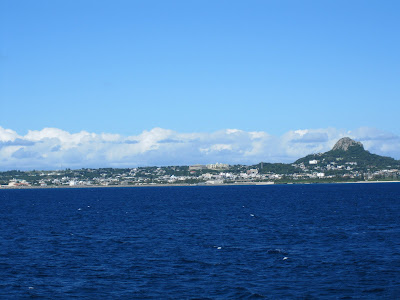 The moment I stepped off the plane, I could feel the difference between Okinawa and Kyoto in the humid cling of the air and the casual postures of the people around me. Okinawa is more like Hawaii than mainland Japan and island life is relaxed to say the least. From the clothing to the buses that come either a few minutes before or a few minutes after their appointed time - a thing that is a rare occurrence for mainland transportation vehicles. The people - from the restaurant owner who gave us free donuts and a ride to the ferry to the girl at the aquarium who, instead of kicking us out during closing time as we made little acorn creatures, made us an origami box to protect our creations from the elements - were remarkably kind.
The moment I stepped off the plane, I could feel the difference between Okinawa and Kyoto in the humid cling of the air and the casual postures of the people around me. Okinawa is more like Hawaii than mainland Japan and island life is relaxed to say the least. From the clothing to the buses that come either a few minutes before or a few minutes after their appointed time - a thing that is a rare occurrence for mainland transportation vehicles. The people - from the restaurant owner who gave us free donuts and a ride to the ferry to the girl at the aquarium who, instead of kicking us out during closing time as we made little acorn creatures, made us an origami box to protect our creations from the elements - were remarkably kind.
They're supposed to be really cute, but mine turned out kind of freaky. Like they're possessed or something.
Anyway, the one other place that a lot of money has been poured into was the Ocean Expo in Motobu - the town where we stayed in for most of the trip. On Monday it was really rainy, so we decided to take advantage of the Ocean Expo, which is this huge expanse of land with exhibits that include botanical gardens, an traditional Okinawan village, an aquarium, obstacle courses for kids and the "Banko Forest" where you can supposedly "forest bathe." Funny thing was, that little bit of fun was only in the English translation and in the Japanese there was no mention of "forest bathing" so I guess only foreigners get to experience the wonders of a forest bath, whatever that is.

We ended up spending most of our time in the aquarium, and I have to say that I've forgotten how impressive aquariums can be. Some of those fish are asbolutely HUGE. There was this one tank with gigantic manta rays and a whale (????) and sharks all mixed into one. Yeah, pretty dynamic. One thing I'd like to point out is that, while the fish may be the same kinds you can find at aquariums in the states, Japanese aquariums definitely have a different atmosphere. I'll give you an example:
*In front of the giant lobster tank*

Me: OMG. Those are FREAKY! They're like giant spiders.
The girls behind me: kore, TABETAI. Literally: I want to eat these.
It seemed like everywhere I went, I heard people evaluating the fish not on how pretty they were or how strange or awe-inspiring etc etc, but on how delicious they looked and how they could be prepared as sashimi/sushi. Or if it's something like octopus, the conversation would turn to tacoyaki (fried octopus balls). It was amazing, but this was a bona fide gustatory excursion for these people! I had no idea that a trip to the aquarium could be such a mouth watering experience...I did notice, however, that at the cafe in the aquarium, there was spaghetti and sandwiches and taco rice, but no sea food...I guess you have to draw the line somewhere ;)
After the aquarium, we went to the dolphin show and once again I was astounded. It was actually really cool and those dolphins can jump HIGH. Like ridiculously high. What movie was it that had the dolphins leaving the earth - or was it taking over the earth - after biding their time manipulating humans into thinking that humans could control them with paltry tricks? Was it Hitchhiker's Guide to the Galaxy? Anyway, I couldn't help but think of that as I watched it. Simply because in that scene the dolphins jump straight up and swim away into the sky and I thought it was ridiculous, but now - while I still think it's ridiculous - I acknowledge that dolphins can jump so high it's like they're flying. What a glorious feeling that must be!


During the whole show the weather behaved itself and there wasn't any rain, but after that, we got to watch the island Ie disappear on the horizon as the rain came thundering towards us and within minutes swept us up in water and wind. For about an hour we had to bide out our time in the gift shop as we waited out the rain, but it was worth it because I think in that hour two-day's worth of rain was bundled up and unleashed so that Tuesday and Wednesday were absolutely beautiful! On those two days we went to the islands Ie and Nina and experienced the most gorgeous beaches ever! And the best thing was, since it's November and the off-season, they were pretty much deserted even though the water was warm enough to swim in! I'm not exaggerating when I say that it was like those paradise posters people hang in dorm rooms and put as their desktop wall-paper.
Nina Island
Well that's about it for now, but more pics can be found on picasa ~
Peace, love and rice balls! jya ne~~ \(^-^)/





















